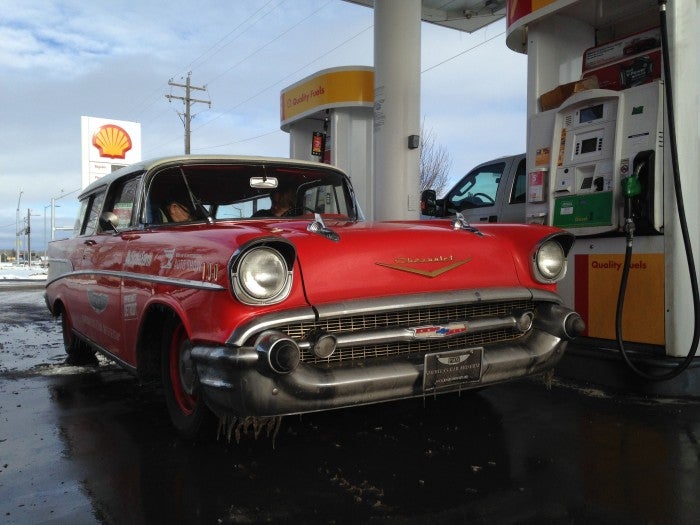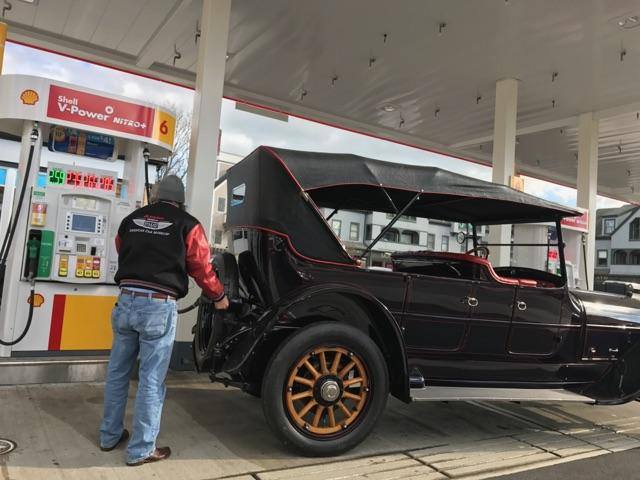
With over three hundred cars on display at any given time at LeMay – America’s Car Museum, it’s sometimes difficult to regularly drive them all. When they’re started and moved for an event or exhibition, it’s often only for a few minutes – not nearly enough time for the cars to reach proper operating temperature.
With modern fuel injection, that’s no big deal. But our older cars use carburetors with mechanical chokes, and short runs can result in a rich burn condition which can accumulate sticky excess fuel deposits in the engine, technically known as “gunk”.
When we took off on the first Drive Home cross-country road trip almost five years ago, we pulled three “driver” classics out of the collection and set off on a 3,200-mile winter passage to Detroit. Our curatorial team prepared three cars with new fluids, filters, plugs and wires. One car – a 1961 Chrysler 300G – utilized a NASCAR-inspired, 413 V-8 engine with dual four-barrel carburetors connected by long ram intake manifolds.

Leaving the Museum in Tacoma, we had no problems. But as we started to encounter real world conditions – cold air, rain, snow, elevation changes and stop-and-go traffic – we began to detect some issues with the big Chrysler engine.
There was a noticeable hiccup when starting out from a stoplight, and on the freeway you could hear a slight rattling sound coming from the combustion chambers. The hesitation was likely a clogged carburetor jet, and the rattling was detonation – a problem caused when the gunk built up in your engine glows red and pre-ignites the fuel mixture being drawn into the engine.
Detonation robs the engine of power, and can cause real damage over time. And sitting behind the wheel listening to it hammer away at your engine for ten days can be disconcerting, to say the least.
But an unexpected thing started to happen as we came down the eastern slope of Mt. Hood in Oregon. Little by little, the rattle seemed to be going away. Idle and throttle response were improving, too. We started to pay attention to the fuel we were using – Shell V-Power NiTRO+ premium gasoline – which we were sourcing via the Station Locator on the Shell phone app.

With each tankful of Shell V-Power NiTRO+, the cars ran better. By the time we hit eastern Colorado, we were charging down on-ramps at full throttle. Idles improved. And that high-performance Chrysler 413 just hummed along like its designers intended.
Normally a chore, we were almost giddy to pull into the next Shell station to see just how much the car’s performance would increase.
Shell attributes this to V-Power’s exclusive additive package, designed to tackle gunk, wear, corrosion and now friction with the new formulation that just launched in May. The fuel’s high detergent content – seven times greater than the federally-mandated requirement – gradually cleared out our car’s carburetors, valvetrains and combustion chambers over extended and consistent use on The Drive Home. Developed with the same technological advantages that the Formula One team Scuderia Ferrari uses, the V-Power NiTRO+ seems ideally suited to our classic car engines.

Now, there’s unlikely to be any scientific data coming out from Shell about the effects of V-Power on old carbureted engines. There’s just too few around. But take it from this old boy who sat behind the wheel for 3,200 miles, and then again in three different classics in three subsequent Drive Home road trips: I don’t pass a Shell station without fueling my own classic up with Shell V-Power NiTRO+. It’s cheap insurance against fuel-related problems, and it feels like a trip to the machine shop after a few tanks. Try it yourself – you’ll feel it in the seat of your pants with your classic car or motorcycle.
William Hall is an automotive journalist based in Elkhart Lake, Wisconsin.